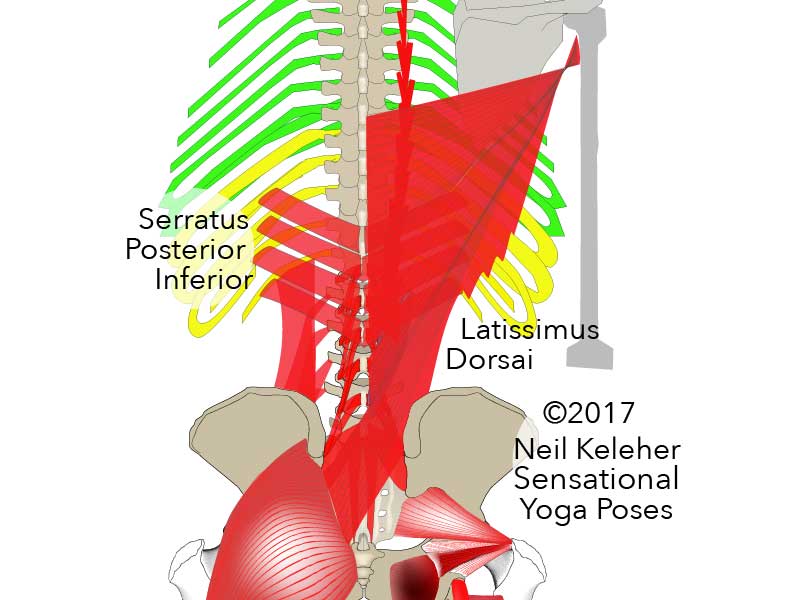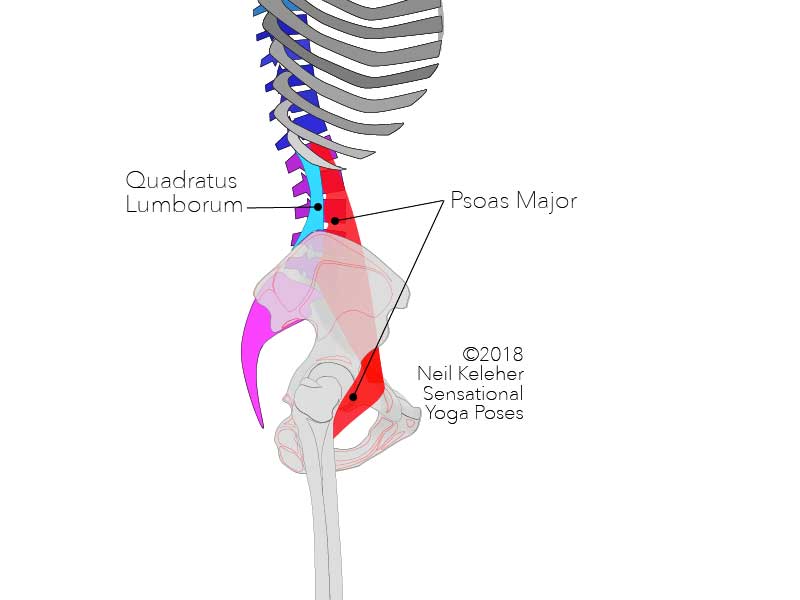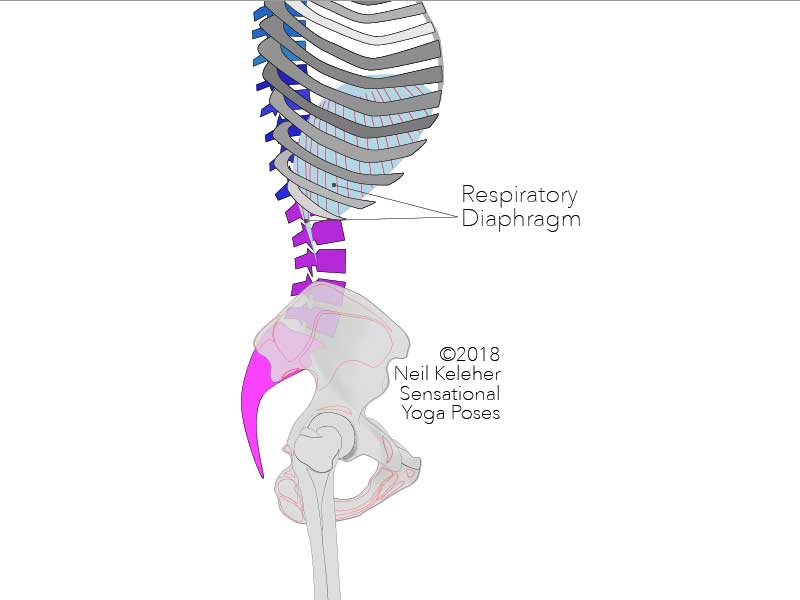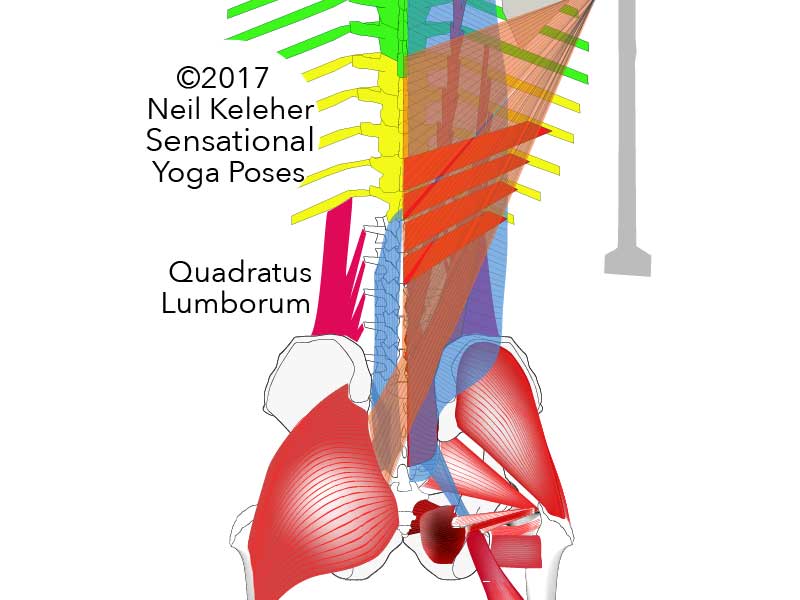Giving the Lats Extra Umph
Part of my usual self practice for the last few years has included hanging. I go through stages of doing and then not doing chin ups or pull ups. I've also been doing straight leg lifts.
The Thoracolumbar Fascia
Having done some reading on the thoracolumbar fascia (TLF), I found out that the serratus posterior inferior, a muscle I hitherto though little about (it seemed pretty minor) attaches from the upper lumbar vertebrae and the lower thoracic vertebrae to the bottom three or four ribs.
It's fibers are directed downwards and inwards from the ribs to the spine, like a downward pointing arrow or chevron.
You might see the term "medial and caudal" used in this regards. It means inwards towards the center line (medial) and also downwards (caudal), away from the skull. ("Lateral and cranial" would indicate outwards (away from the center line) and towards the skull.)
The latissimus dorsai also has attachments to the lower two ribs and one of the ideas that I experiment on was using the posterior serratus posterior to pull down on the bottom ribs giving those particular fibers of the latissimus dorsai a more stable foundation from which to pull down from. My thought was that I could then utilize more of the latissimus dorsai in pull ups or chin ups by first pulling down on the bottom ribs.
Forward Bends Both With and Without Low Back Pain
Soon after reading about the thoracolumbar fascia I began to experience low back discomfort while doing forward bends.
Previously when I did forward bends, I often taught (and did) a reaching action with the arms and spine, making the arms, neck and the rest of the spine feel long. I even when so far as to reach forward with my eyes.
While a good instruction, and possibly one that if I continued to do would see my back pain disappear I also wanted to be able to do a forward bend without back pain but also without the need to reach my arms forwards, (or similarly grab on to my feet and then pull back on my feet).
Activating the Latissimus Dorsai While Bending Forwards
Probably what happens while bending forwards with the arms reaching forward is that the lats are activated (to help create the feeling of length in the arms and spine) which may help to pull the ribs away from the pelvis and that in turn gives the posterior serratus inferior a foundation from which to pull on the rear of the lumbar spine.
So why would that help prevent back pain while forward bending (and while I'm here I might as well mention that in a deep squat with the spine bent forwards between the knees, I also felt a similiar sort of low back pain.)
Stabilizing the Lumbar Spine
Reading about the lumbar spine, there are few muscles that act directly on the front of the lumbar vertebrae.
The psoas major reaches up from the inner thigh (passing forwards to the front of the pelvis and then folding around the front of the pelvis) to reach back to attach to the sides of the bodies and the fronts of the transverse processes of the lumbar vertebrae.
Meanwhile the respiratory diaphragm has fibers that attach to the upper three most lumbar vertebrae. These are the only muscles that directly attach to the front of the lumbar spine.
At the back we have the multifidus which attach cranially and medially to form a series of upward pointing arrows or chevrons as they attach from transverse process of lower vertebrae to the spinous process of higher vertebrae (either one, two or three levels up.)
The Quadratus Lumborum
Another muscle that attaches to the lumbar vertebrae is the Quadratus Lumborum.
This muscle has its base on the back of the pelvis and its fascicles reach upwards and inwards (cranially and medially) to attach from there to the transverse processes of the upper four lumbar vertebrae. It also has fibers that reach straight upwards to attach to the bottom of the lowest rib.
It's a challenging muscle to understand because the only way it can seem to work is pulling down on one side or the other to help side bend the spine, or perhaps activating on both sides to keep the spine from bending laterally. It would also seem that it helps to bend the lumbar spine backwards (extending the lumbar spine) but depending on whether the lumbar spine is already bent forwards (flexed) or bend backwards (extended) the affect of the quadratus lumborum contracting could be different.
Interactions of the QL and TA
When trying to illustrate the thoracolumbar fascia, one thing that I realized is that the Transverse Abdominus (TA) passes behind the Quadratus Lumborum (QL) to attach to the transverse process of the lumbar spine.
The Paraspinalis muscles (the muscles that run along the back of the body on either side of the spine and includes both the Spinal Erectors and Multifidus), are encased in an open sided tube of connective tissue that wraps those muscles to the spine.
In the lumbar region the front wall of that tube (the technical name now used is paraspinalis rectinacular sheath or PRS) is formed in part by fibers of the Transverse Abdominus.
The serratus posterior inferior actually forms part of the rear wall of PRS. But that's incidental (or at least I think it is, at least in regards to back pain and forward bends.)
What occurred to me on seeing how the transverse abdominis passes behind the quadratus lumborum, is that tension in the transverse abdominus could actually pull the quadratus lumborum forwards, towards the front of the abdomen, adding tension to that muscle and in addition slightly changing the angle with which the fibers of that muscle (the QL) act on the lumbar vertebrae.
In a forward bend for the hips, the lumbar spine generally bends forwards as well (so that both the hips and the lumbar spine are "flexed"). Contracting the transverse abdominus could make it easier for the QL to contract. With the lumbar spine already flexed, this could help to keep the lumbar spine flexed. Thus the multifidus then can act to try to stabilize the lumbar spine, so that it is stabilized from the front and back. The effect would be as if to stabilize the lumbar spine from bottom to top. But what if this isn't enough? What if it also needs to be stabilized from top to bottom, particularly the upper half?
Serratus Posterior Inferior
The Answer to Low Back Pain in Forward Bends?
Enter the posterior serratus inferior.
It attaches from the lower four ribs to the lower two thoracic vertebrae and the upper two or three lumbar vertebrae. As mentioned previously, one way in which this muscle might be useful is stabilizing the lower ribs (by pulling downwards on them) so that more fibers of the latissimus dorsai muscle can be used. However, if the ribs are stabilized (either by using the latissimus dorsai, or the intercostal muscles, muscles that attach between the ribs) then the serratus posterior inferior can be used to help flatten and support the upper region of the lumbar spine.
Creating a Foundation for the Serratus Posterior Inferior
So that the posterior serratus inferior have a stable base (and length enough) to contract and act effectively on the lumbar spine, it may help to lift the back ribs, using the intercostals. It may also help if the thoracic spine is bend forwards.
Bending the thoracic spine forwards slightly (flexing it) can make it easier to feel and lift the back ribs. Lifting the back ribs, and keeping them lifted, the idea is then to create a downward pull on the backs of the bottom three ribs. That would indicate that the posterior serratus inferior is activating.
I find that it helps to have the belly pulled in (a sign that the transverse abdominus is activated.)
I've also found that I've had to experiment with slight variations in position, ribs lifted or not lifted, belly in or relaxed, ribcage slightly slid to one side or the other to get even engagement of the serratus posterior inferior on both sides.
It may come that with enough practice you don't have to consciously pull down on the lower back ribs to activate posterior serratus inferior. It activates automatically.
So Why is the SPI Needed to Prevent Low Back Pain In Deep Forward Bends?
To finish with it might be interesting to figure out why, in deep forward bends, and deep squats with the spine bent forwards, the low back gets weak.
As mentioned the psoas bends around the front of the pelvis to attach to the lumbar spine, at least while standing upright.
Bending forwards at the hips past a certain point causes the fibers of the psoas to unbend.
They no longer have to bend around the upper lip of the front of the pelvis in order to connect thigh to lumbar spine. The connection becomes a fanned out group of straight lines.
Not only is the psoas now spanning a shorter distance it not longer has the mechanical advantage of folding around the pelvis. As such it's affect on the lumbar spine is weakened. It can not longer support the front of the spine as effectively. And that's why we may need the serratus posterior inferior to come into play.
An Alternative Action that May Help Low Back Pain
Note that an alternative activation that might also be helpful relies on a connection between the respiratory diaphragm, renal fascia and psoas major and 12th pair of ribs.
Simply put, pulling upwards on the rear of the kidneys can be used to add tension to the psoas. That may be enough to give the lumbar spine support from the front. Here again it may still be helpful to keep the belly pulled in so that the transverse abdominus is active.
Note that the relevant fibers of the diaphragm and renal fascia also attach to the 12th pair of ribs (the lowest pair of ribs) and so an alternative instruction is to pull upwards on that pair of ribs in order to add tension to the psoas, support the lumbar spine and alleviate low back pain while bending forwards.
Published: 2020 08 13






